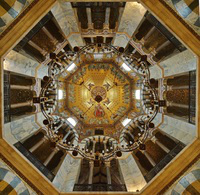With precise determinations of the lifetime and angular correlations in the decay of the neutron, we can characterize the left-handed nature of the weak interaction and search for the influence of new interactions. The Nab experiment's primary goal is to determine the ratio of the hadronic axial-vector and vector form factors with a goal sensitivity of $\delta\lambda/\lambda\sim0.03\%$, which...
Nuclear beta decay has a long-standing history of shaping and testing the standard model of particle physics, and it continues to this day with elegant, ultra-precise low-energy nuclear measurements. Experiments observing the angular correlations between the electron, neutrino and recoil momenta following nuclear beta decay can be used to search for exotic currents contributing to the...
Searches for violations of the fundamental discrete symmetries parity (P), time reversal (T) and charge conjugation (C) provide guidelines for model building beyond the Standard Model of the electroweak interactions (SM).
Measurements of atomic parity violation (APV) provide a test the electroweak interactions at low energies, while other experiments like searches for permanent electric...
In the study of electroweak interactions, atomic parity violation (PV) experiments form a powerful tool, providing valuable information about the Standard Model and low-energy nuclear physics. Ytterbium (Yb) and dysprosium (Dy) are good systems for such studies, due to their strong PV effect (to be confirmed for Dy) and the availability of many stable isotopes. This brings within reach the...
Parity violation (PV), first observed in semileptonic decays, has been determined precisely for quarks and leptons as part of the standard model. At the hadronic level, it offers a unique probe of nucleon structure and the underlying low-energy behavior of non-perturbative QCD. The hadronic weak interaction is characterized in terms of five spin and isospin dependent S-P transition...
NPDGamma is an experimental collaboration which for over 20 years has made an effort in research and development to measure the parity-violating gamma-ray asymmetry in the capture of polarized low-energy neutrons on hydrogen. This asymmetry is dominated by a $\Delta I=1$ ${}^{3}S_{1}-{}^{3}P_{1}$ parity-odd transition in the $n-p$ system. In the more traditional theoretical framework, the...
The Qweak experiment precisely measures the proton's weak charge using parity-violating elastic electron scattering from the proton at Jefferson Laboratory. The Standard Model makes a firm prediction for the proton's weak charge, thus providing a sensitive test for new physics beyond the Standard Model. This talk will cover the measurement methodology, key technical challenges, and the most...
We are developing experiments to study parity nonconservation effects in neutral francium atoms at the ISAC radioactive beam facility at TRIUMF. We are using laser cooling and trapping techniques to prepare the atoms for our measurements and our current effort is based on optical spectroscopy of Stark induced 7s-8s atomic transitions aiming at Standard Model test of the strength of the...
In this talk I will review the current status of the radioisotopes trapping program at the Soreq Applied Research Accelerator Facility (SARAF), and prospects for measurements at the upgraded accelerator: SARAF-II.
In our new lab complex, situated above the SARAF target room, we utilize two systems: An electrostatic-ion-beam-trap,designed for trapping various radioactive ions, starting with...
